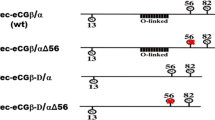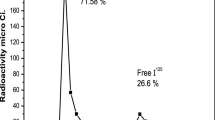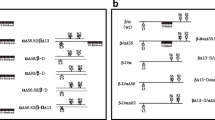Abstract
Human chorionic gonadotropin (hCG), purified from the urine of 14 individuals with normal pregnancy, diabetic pregnancy, hydatidiform mole, or choriocarcinoma, plus two hCG standard preparations, was examined for concurrent peptide-sequence and asparagine (N)- and serine (O)-linked carbohydrate heterogeneity. Protein-sequence analysis was used to measure amino-terminal heterogeneity and the “nicking” of internal peptide bonds. The use of high-pH anion-exchange chromatography coupled with the increased sensitivity of pulsed amperometric detection (HPAE/PAD) revealed that distinct proportions of both hCG α- and β-subunits from normal and aberrant pregnancy are hyperglycosylated, and that it is the extent of the specific subunit hyperglycosylation that significantly increases in malignant disease.
Peptide-bond nicking was restricted to a single linkage (β47–48) in normal and diabetic pregnancy, but occurred at two sites in standard preparations, at three sites in hydatidiform mole, and at three sites in choriocarcinoma β-subunit. In the carbohydrate moiety, α-subunit from normal pregnancy hCG contained non-fucosylated, mono-and biantennary N-linked structures (49.3 and 36.7%, means); fucosylated biantennary and triantennary oligosaccharides were also identified (7.3 and 6.9%). In choriocarcinoma α-subunit, the level of fucosylated biantennary increased, offset by a parallel decrease in the predominant biantennary structure of normal pregnancy (P<0.0001). The β-subunit from normal pregnancy hCG contained fucosylated and nonfucosylated biantennary N-linked structures; however, mono- and triantennary oligosaccharides were also identified (4.6 and 13.7%). For O-linked glycans, in β-subunit from normal pregnancy, disaccharidecore structure predominated, whereas tetrasaccharide-core structure was also detected (15.6%). A trend was demonstrated in β-subunit: the proportions of the nonpredominating N- and O-linked oligosaccharides increased stepwise from normal pregnancy to hydatidi-form mole to choriocarcinoma. The increases were: for monoantennary oligosaccharide, 4.6 to 6.8 to 11.2%; for triantennary, 13.7 to 26.7 to 51.5% and, for O-linked tetrasaccharide-core structure, 15.6 to 23.0 to 74.8%. For hCG from individual diabetic pregnancy, the principal N-linked structure (34.7%) was consistent with a biantennary oligosaccharide previously reported only in carcinoma; and sialylation of both N- and O-linked antennae was significantly decreased compared to that of normal pregnancy.
Taken collectively, the distinctive patterns of subunit-specific, predominant oligosaccharides appear to reflect the steric effect of local protein structure during glycosylation processes. The evidence of alternative or “hyperbranched” glycoforms on both α- and β-subunits, seen at low levels in normal pregnancy and at increased or even predominant levels in malignant disease, suggests alternative substrate accessibility for Golgi processing enzymes, α1,6fucosyltransferase andN-acetylglucosaminyltransferase IV, in distinct proportions of subunit molecules.
Similar content being viewed by others
References
Roche, P. C. and Ryan, R. J. (1985). In:Luteinizing Hormone Action and Receptors. Ascoli, M. (ed.). CRC: Boca Raton, pp. 17–56.
Hunzicker-Dunn, M. H. and Birnbaumer, L. (1985). In:Luteinizing Hormone Action and Receptors. Ascoli, M. (ed.): CRC: Boca Raton, pp. 57–134.
Harbour-McMenamin, D., Smith, E. M. and Blalock, J. E. (1986).Proc. Natl. Acad. Sci. USA 83, 6834–6838.
Yagel, S., Geva, T. E., Solomon, H., Shimonovitz, S., Reich, R., Finci-Yeheskel, Z., Mayer, M. and Milwidsky, A. (1993).J. Clin. Endocrinol. Metab. 77, 1506–1511.
Pierce, J. G. and Parsons, T. F. (1981).Ann. Rev. Biochem. 50, 465–495.
Wu, H., Lustbader, J. W., Liu, Y., Canfield, R. E., and Hendrickson, W. A. (1994).Structure 2, 545–558.
Li, E., Tabas, I. and Kornfeld, S. (1978).J. Biol. Chem. 253, 7762–7770.
Peters, B. P., Krzesicki, R. F., Hartle, R. J., Perini, F., and Ruddon, R. W. (1984).J. Biol. Chem. 259, 15,123–15,130.
Kornfeld, S., Li, E., and Tabas, I. (1978).J. Biol. Chem. 253, 7771–7778.
Birken, S. and Canfield, R. E. (1977).J. Biol. Chem. 252, 5386–5392.
Keutmann, H. T. and Williams, R. M. (1977).J. Biol. Chem. 252, 5393–5397.
Huth, J. R., Mountjoy, K., Perini, F., and Ruddon, R. W. (1992).J. Biol. Chem. 267, 8870–8879.
Birken, S. and Canfield, R. E. (1978) In:Structure and Function of the Gonadotropins. McKerns, K. W. (ed.), Plenum: New York, pp. 47–80.
Kardana, A., Elliott, M. M., Gawinowicz, M.-A., Birken, S., and Cole, L. A. (1991).Endocrinology 129, 1541–1550.
Bidart, J.-M., Puisieux, A., Troalen, F., Foglietti, M. J., Bohuon, C., and Bellet, D. (1988).Biochem. Biophys. Res. Commun. 154, 626–632.
Nishimura, R., Ide, K., Utsunomiya, T., Kitajima, T., Yuki, Y., and Mochizuki, M. (1988).Endocrinology 123, 420–425.
Cole, L. A., Kardana, A. and Birken, S. (1989).Serono Symposium 65, 59–78.
Kessler, M. J., Reddy, M. S., Shah, R. H., and Bahl, O. P. (1979).J. Biol. Chem. 254, 7901–7908.
Endo, Y., Yamashita, K., Tachibana, Y., Tojo, S. and Kobata, A. (1979).J. Biochem. (Tokyo) 85, 669–679.
Nilsson, B., Rosen, S. W., Weintraub, B. D. and Zopf, D. A. (1986).Endocrinology 119, 2737–2743.
Weisshaar, G., Hiyama, J. and Renwick, A. G. C. (1991).Glycobiology 1, 393–404.
Kessler, M. J., Mise, T., Ghai, R. D. and Bahl, O. P. (1979).J. Biol. Chem. 254, 7909–7914.
Cole, L. A. (1987).J. Clin. Endocrinol. Metab. 65, 811–813.
Amano, J., Nishimura, R., Mochizuki, M., and Kobata, A. (1988).J. Biol. Chem. 263, 1157–1165.
Mizuochi, T., Nishimura, R., Derappe, C., Taniguchi, T., Hamamoto, T., Mochizuki, M., and Kobata, A. (1983).J. Biol. Chem. 258, 14,126–14,129.
Mizuochi, T., Nishimura, R., Taniguchi, T., Utsunomiya, T., Mochizuki, M., Derappe, C. and Kobata, A. (1985).Jpn. J. Cancer Res. (Gann) 76, 752–759.
Skarulis, M. C., Wehmann, R. E., Nisula, B. C. and Blithe, D. L. (1992).J. Clin. Endocrinol. Metab. 75, 91–96.
Wide, L., Lee, J.-Y., and Rasmussen, C. (1994).J. Clin. Endocrinol. Metab. 78, 1419–1423.
Diaz-Cueto, L., Mendez, J. P., Barrios-de-Tomasi, J., Lee, J.-Y., Wide, L., Veldhuis, J. D. and Ulloa-Aguirre, A. (1994).J. Clin. Endocrinol. Metab. 78, 890–897.
Stockell Hartree, A. and Renwick, A. G. C. (1992).Biochem. J. 287, 665–679.
Blithe, D. L. (1990).Endocrinology 216, 2788–2799.
Williams, D., Longmore, G., Matta, K. L., and Schachter, H. (1980).J. Biol. Chem. 255, 11,253–11,261.
Birken, S., Chen, Y., Gawinowicz, M.-A., Lustbader, J. W., Pollack, S., Agosto, G., Buck, R. and O’Connor, J. (1993).Endocrinology 133, 1390–1397.
Yamashita, K., Totani, K., Iwaki, Y., Takamisawa, I., Tateishi, N., Higashi, T., Sakamoto, Y., and Kobata, A. (1989).J. Biochem. (Tokyo) 105, 728–735.
Lustbader, J., Birken, S., Pollack, S., Levinson, L., Bernstine, E., Hsiung, N., and Canfield, R. (1987).J. Biol. Chem. 262, 14,204–14,212.
Calvo, F. O. and Ryan R. J. (1985).Biochemistry 24, 1953–1959.
Matzuk, M. M., Keene, J. L., and Boime, I. (1989).J. Biol. Chem. 264, 2409–2414.
Gordon, W. L. and Ward, D. N. (1985). In:Luteinizing Hormone Action and Receptors. Ascoli, M. (ed.), CRC: Boca Raton, pp. 174–197.
Ryan, R. J., Charlesworth, M. C., McCormick, D. J., Milius, R. P., and Keutmann, H. T. (1988).FASEB J. 2, 2661–2669.
Keutmann, H. T., Ratanabanagkoon, K., Pierce, M. W., Kitzmann, K., and Ryan, R. J. (1983).J. Biol. Chem. 258, 14,521–14,526.
Sakakibara, R., Miyazaki, S. and Ishiguro, M. (1990).J. Biochem. 107, 858–862.
Cole, L. A., Kardana, A., Andrade-Gordon, P., Gawinowicz, M.-A., Morris, J. C., Bergert, E. R., O’Conner, J., and Birken, S. (1991).Endocrinology 129, 1559–1567.
Matzuk, M. M., Krieger, M., Corless, C. L., and Boime, I. (1987).Proc. Natl. Acad. Sci. USA 84, 6354–6358.
LaPolt, P. S., Nishimori, K., Fares, F. A., Perlas, E., Boime, I., and Hsueh, A. J. (1992).Endocrinology 131, 2514–2520.
Huang, J., Chen, F., and Puett, D. (1993).J. Biol. Chem. 268, 9311–9315.
Kardana, A. and Cole, L. A. (1992).Clin. Chem. 38, 26–33.
Elegbe, R. A., Pattillo, R. A., Hussa, R. O., Hoffmann, R. G., Damole, I. O., and Finlayson, W. E. (1984).Obstet. Gynecol. 63, 335–337.
Hardy, M. R., Townsend, R. R. and Lee, Y. C. (1988).Anal. Biochem.,170, 54–62.
Morgan, F. J., Birken, S. and Canfield, R. E. (1975).J. Biol. Chem. 250, 5247–5258.
Author information
Authors and Affiliations
Rights and permissions
About this article
Cite this article
Elliott, M.M., Kardana, A., Lustbader, J.W. et al. Carbohydrate and peptide structure of the α- and β-subunits of human chorionic gonadotropin from normal and aberrant pregnancy and choriocarcinoma. Endocr 7, 15–32 (1997). https://doi.org/10.1007/BF02778058
Received:
Accepted:
Issue Date:
DOI: https://doi.org/10.1007/BF02778058




